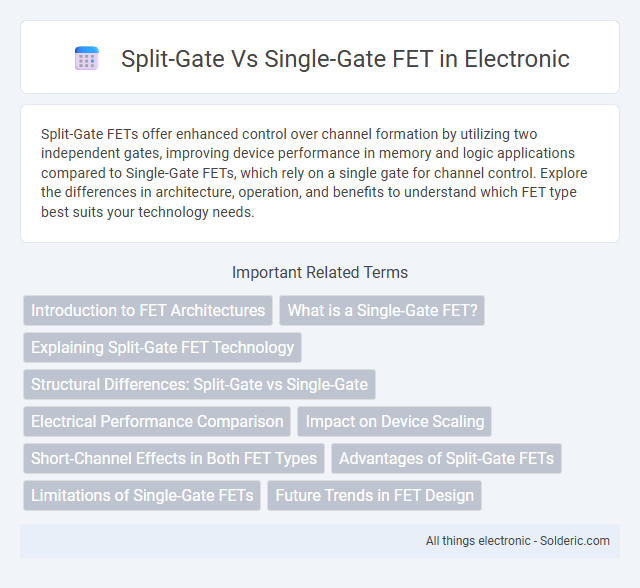Split-Gate FETs offer enhanced control over channel formation by utilizing two independent gates, improving device performance in memory and logic applications compared to Single-Gate FETs, which rely on a single gate for channel control. Explore the differences in architecture, operation, and benefits to understand which FET type best suits your technology needs.
Comparison Table
| Aspect | Split-Gate FET | Single-Gate FET |
|---|---|---|
| Gate Structure | Two separate gates controlling the channel | One continuous gate controlling the channel |
| Control | Improved electrostatic control and reduced short channel effects | Standard control, potentially more short channel effects |
| Fabrication Complexity | Higher due to multiple gates and isolation | Simpler and more cost-effective |
| Performance | Better current drive and leakage control | Good performance but higher leakage current |
| Applications | High-performance and low-power circuits | General purpose and mainstream applications |
Introduction to FET Architectures
Field-Effect Transistor (FET) architectures vary in gate configurations, influencing device performance and scalability. Split-Gate FETs feature two independent gates controlling a single channel, enabling enhanced electrostatic control and reduced short-channel effects compared to Single-Gate FETs, which utilize one gate over the channel. Your choice between these architectures impacts device switching speed, leakage current, and integration density in semiconductor applications.
What is a Single-Gate FET?
A Single-Gate Field-Effect Transistor (FET) features one gate terminal that controls the current flow between the source and drain by modulating the channel conductivity. It is widely used in digital and analog circuits due to its simplicity and efficient switching behavior. Compared to Split-Gate FETs, Single-Gate FETs offer straightforward fabrication and consistent electrical characteristics.
Explaining Split-Gate FET Technology
Split-Gate FET technology incorporates two gates separated by a narrow gap, allowing precise control over the channel region and reducing short-channel effects compared to Single-Gate FETs. This architecture enhances device scalability, minimizes leakage currents, and improves threshold voltage control, making it ideal for advanced CMOS applications. By modulating the potential in different channel segments independently, Split-Gate FETs achieve superior performance metrics such as higher drive current and better subthreshold slope.
Structural Differences: Split-Gate vs Single-Gate
Split-Gate FETs feature two distinct gate electrodes positioned on either side of the channel, enabling enhanced control over the electric field and improved device performance. Single-Gate FETs utilize a single gate electrode that modulates the channel conductivity from one side, resulting in simpler fabrication but potentially less precise electrostatic control. The dual-gate structure in Split-Gate devices reduces short-channel effects and leakage currents compared to the single-gate design.
Electrical Performance Comparison
Split-Gate FETs offer improved control over channel conduction by utilizing two independently biased gates, resulting in lower short-channel effects and enhanced subthreshold slope compared to Single-Gate FETs. The dual-gate structure of Split-Gate FETs reduces gate leakage current and improves on/off current ratio, thereby boosting overall device switching speed and power efficiency. Your circuit's electrical performance can benefit significantly from selecting Split-Gate FETs in high-speed and low-power applications due to these characteristics.
Impact on Device Scaling
Split-Gate FETs enable improved short-channel control and reduced leakage currents compared to Single-Gate FETs, significantly benefiting device scaling at advanced technology nodes. The dual-gate architecture of Split-Gate FETs enhances electrostatic control over the channel, mitigating short-channel effects that hinder Single-Gate FET performance as device dimensions shrink. Your integrated circuit designs see enhanced scalability and power efficiency by adopting Split-Gate FET structures over conventional Single-Gate approaches.
Short-Channel Effects in Both FET Types
Split-Gate FETs exhibit improved control over short-channel effects compared to Single-Gate FETs due to their dual-gate configuration, which reduces drain-induced barrier lowering (DIBL) and threshold voltage roll-off. The enhanced electrostatic control in Split-Gate FETs minimizes leakage currents and maintains device performance at reduced channel lengths, addressing scaling challenges. Your choice of transistor type significantly impacts device reliability and power efficiency in sub-50nm technology nodes.
Advantages of Split-Gate FETs
Split-Gate FETs offer enhanced control over the channel by utilizing two independently biased gates, leading to better suppression of short-channel effects compared to Single-Gate FETs. This structure improves subthreshold slope and reduces leakage current, resulting in lower power consumption and increased device reliability. Furthermore, Split-Gate FETs demonstrate higher drive currents and improved scalability for advanced low-power and high-performance CMOS technologies.
Limitations of Single-Gate FETs
Single-gate FETs face significant scaling challenges due to short-channel effects, which degrade device performance as transistor dimensions shrink. Their limited electrostatic control leads to increased leakage currents and reduced switching speed, impacting overall circuit efficiency. These constraints hinder further miniaturization and performance improvements in advanced semiconductor technologies.
Future Trends in FET Design
Future trends in FET design emphasize the transition from single-gate to split-gate architectures to enhance device scalability and electrostatic control. Split-gate FETs provide superior suppression of short-channel effects and improved subthreshold swing compared to single-gate FETs, enabling lower power consumption and higher performance in nanoscale transistors. Advances in materials and fabrication techniques are driving the integration of split-gate structures in next-generation logic and memory devices, supporting the continued miniaturization and efficiency demands in semiconductor technology.
Split-Gate vs Single-Gate FET Infographic

 solderic.com
solderic.com